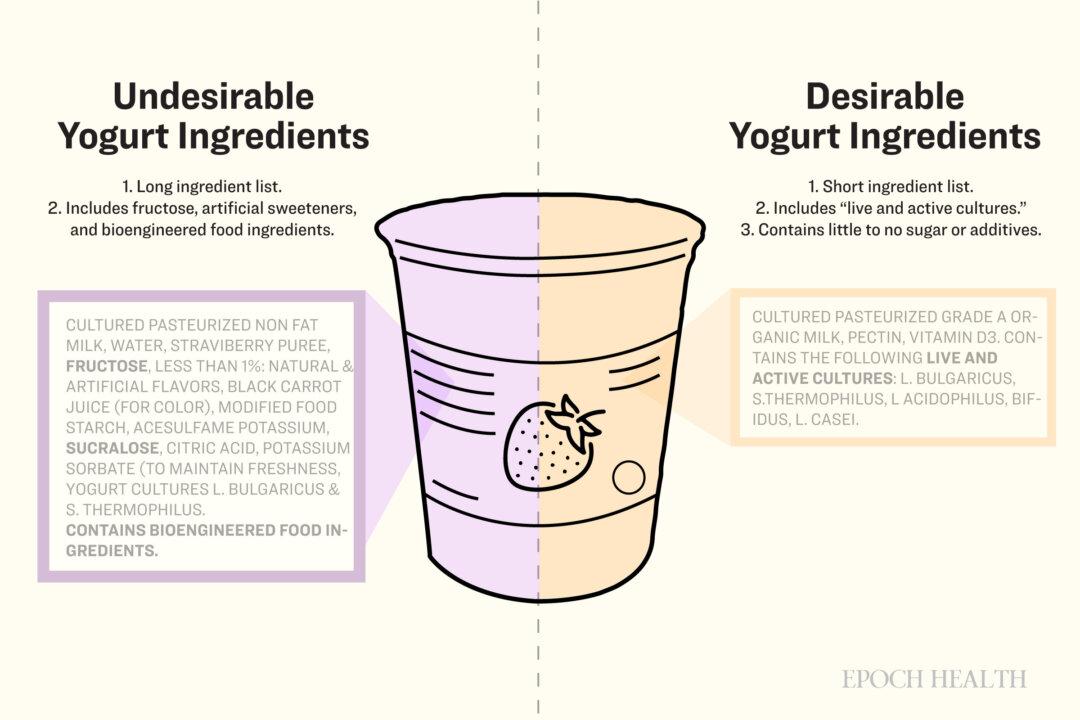Yogurts are often thought of as healthy foods, but some types may be sabotaging your health goals and gut.
Don’t be fooled by flashy marketing labels—many popular brands pack as much sugar as ice cream and lack the live probiotics to boost your body. But you can learn how to spot truly beneficial yogurts that will nourish your body.
Does Your Yogurt Really Contain Probiotics?
Not all yogurts contain active probiotics.
To be considered probiotic, it needs to have live microorganisms that confer a health benefit to you —similar to the beneficial bacteria that would normally live in your gut.
In regular yogurt production, cow’s milk undergoes heat treatment to eliminate pathogens. Live active cultures are then added to begin the fermentation process. Some yogurts are again heat-treated to kill other microorganisms after culturing to extend product shelf life. If yogurt is heat-treated after the probiotic cultures are added, the good microbes will die off, eliminating any potential benefits.

Illustration by The Epoch Times, Shutterstock
Lactobacillus bulgaricus and Streptococcus thermophilus are the two main bacteria used in yogurt starters to convert milk sugar, lactose, into lactic acid. These strains do not survive the stomach’s acidity and pancreatic enzymes. Many manufacturers now add probiotic bacterial strains such as Lactobacillus acidophilus, Lactobacillus casei, or Bifidobacterium spp. There is evidence that these bacteria survive through to the intestines. With this in mind, be aware that not all the cultures listed on a yogurt label will necessarily reach your gut.
Having one specific strain or more than one strain is not necessarily better as it depends on the particular health benefit you want. Lactobacilli can enhance immunity and provide anti-inflammatory actions. Bifidobacteria are important producers of short-chain fatty acids—a major source of energy for (epithelial) gut lining cells that improve the gut barrier.
The good bacteria in yogurt must be alive and at levels high enough to provide a potential health benefit. Yogurt labels have a “live active cultures” seal, meaning they contain at least 100 million cultures per gram at the time of manufacturing. Food products do not state the quantity of bacteria like probiotic supplements do. A healthy yogurt will contain statements similar to the label on the right pictured below.

(Illustration by The Epoch Times)
Other Benefits of a Good Yogurt
Beyond aiding digestion, research suggests that high-quality yogurt can strengthen the immune system and provide essential nutrients such as calcium, protein, and fat. These nutrients contribute to satiety, reducing hunger and cravings.
Other studies indicate that consuming probiotic foods and beverages may help regulate blood sugar levels and improve insulin sensitivity, thus preventing or delaying the onset of Type 2 diabetes and numerous inflammatory conditions, including obesity.
Best Probiotic-Rich Options
From traditional to nondairy, there’s an option to suit every taste and dietary preference.
Kefir
Although not technically yogurt, kefir is a popular fermented milk drink found in the same refrigerated section of grocery stores. Kefir is a superior source of probiotics boasting a wider bacterial diversity with around 300 species and 61 strains of microbes.
Kefir grains, which have a similar shape to cauliflower florets, are not grains at all, but rather tiny clusters of bacteria and yeast used in the fermentation process. These grains occur naturally and cannot be artificially created in a laboratory, meaning that the grains used to make kefir today are direct descendants of those discovered around 4000 B.C.
During fermentation, microbes feed on kefir grains, multiplying and changing the milk’s flavor to its unique tangy taste while increasing its probiotic content. In research, the unique bacterial combination found in kefir provided further benefits, with enhanced insulin sensitivity and blood lipids in Type 2 diabetic patients.

Kefir is a superior source of probiotics. (Esin Deniz/Shutterstock)
Regular Yogurt
Regular yogurt can be made using full-fat or low-fat pasteurized cow’s milk.
Some organic dairy yogurts will state they use milk sourced from cows not treated with genetically engineered growth hormone (rBGH) or recombinant bovine somatotropin (rBST). These synthetic hormones can increase cow’s milk production and while the composition of milk does not change, its human health safety is unclear. Some studies have shown that milk from cows treated with rBGH contains more insulin-like growth factor 1 than untreated cows. Connections have been made between the consumption of IGF-1 and an increased risk of breast and other cancers.
The best option is unsweetened or plain yogurt that doesn’t contain any additives. If you prefer a sweetened yogurt, one that has relatively low amounts of organic sugar alongside an equally balanced ratio of protein, fat, and only slightly more sugar is ideal. Or add a bit of honey to plain yogurt for even greater probiotic benefits.
A three-quarter cup serving might be seven grams of protein, seven grams of fat, and 10 grams of sugar (mostly from the milk sugar and lactose).
Some brands will list on their label natural sweeteners such as monk fruit or stevia, which have minimal impact on blood sugar.
Yogurts can be made by using different bases for fermentation—such as goat and sheep milk—as good alternatives, if you have digestive issues with cow dairy, as they are both sources of A2 protein. A2 milk is a type of milk that lacks the milk protein, beta-casein found in A1 milk. Most breeds of cows produce milk that contains the beta-casein protein (A1). Increased gastrointestinal inflammation, digestive discomfort, and slower cognition are associated with A1 milk, with research ongoing in this area.
Greek Yogurt
Greek yogurt is regular yogurt that has been strained, removing the whey, in order to produce a thicker, creamier texture. This process increases its probiotic and protein content while usually reducing sugar. As a complete protein from an animal source, dairy yogurt contains all nine essential amino acids.
Greek yogurt often has less lactose than traditional yogurt due to its lower sugar content, making it more tolerable for lactose-sensitive people.
To make a dairy-based lactose-free yogurt, manufacturers add the enzyme lactase to break down lactose into simple sugars that are easier to digest. Bacteria then feed on these sugars during the fermentation process.
Nondairy Yogurts
Different fermentation bases such as coconut, almond, or cashew may be good dairy alternatives, but the sugar content can vary widely among brands. Some small tubs of yogurt have low sugar content, around eight grams (two teaspoons), while others have as much as 24 grams (six teaspoons) per serving.
If you tolerate or prefer soy products, check that they are organic and non-GMO, and look for the sugar content and additives. Oat-based products are now available and are best if organic, as conventional oats have been found to contain high levels of glyphosate, a common herbicide linked to cancer as well as digestive and respiratory problems.
Most nondairy products have gums added for a thicker, fuller texture similar to dairy yogurts. These can cause abdominal discomfort in some people, so check ingredient lists if you’re sensitive.
Newer combinations are coming out all the time with unique ingredients, one such type uses nutritional fungi. These laboratory-made products require more independent investigation to evaluate their long-term safety and efficacy. Current research is limited to studies funded by food manufacturers. Excessive fungi consumption may increase the risk of yeast overgrowth and create digestive imbalances. Caution is advised when experimenting with new formulas.
Another new yogurt blend, containing natural ingredients and no added gums, is made with pili nuts, coconuts, green plantains, and cassava root, with live probiotics and prebiotic fiber. Availability may vary depending on your location, but it’s worth trying if you’re feeling adventurous.
Tips for Making the Healthiest Yogurt Choices
If all these choices seem overwhelming and you want to spend your money wisely, remember to look at the ingredients list—not just the nutrition panel. If you only look at the sugars, fats, and proteins, you may miss the mark and get something loaded with other nasties and none of the good things.
Prioritize a product that first contains active probiotics, and second contains no or little sugar. There can be multiple names for added sweeteners such as fructose or sucralose (anything ending with -ose is a sugar) and syrups such as corn or tapioca syrup. You can control the sweetness to your taste by adding low-sugar fruits such as blueberries or natural sweeteners such as organic stevia, which won’t spike your blood sugar levels.
Third, avoid yogurts full of extra ingredients, such as additives like gums, vegetable oils, flavors, or colors.
With the wide variety available and some simple label deciphering, yogurt can be an affordable and enjoyable probiotic health food.









